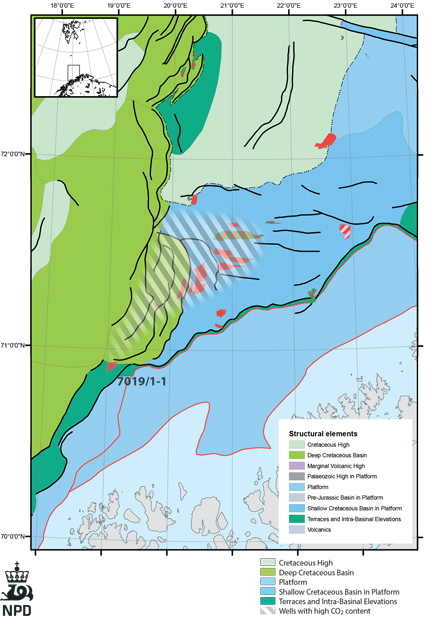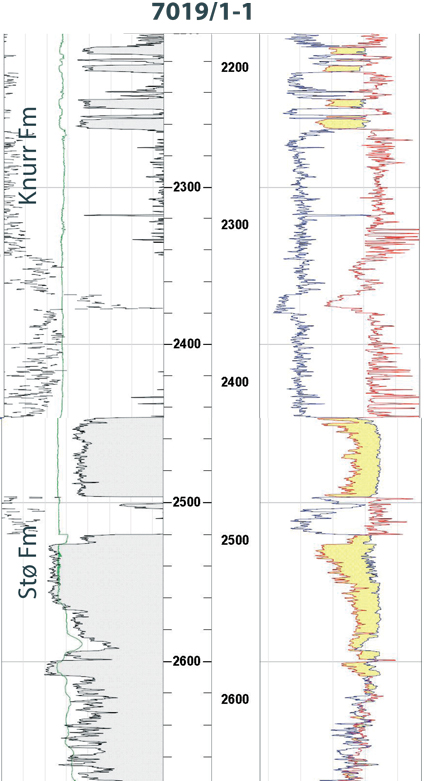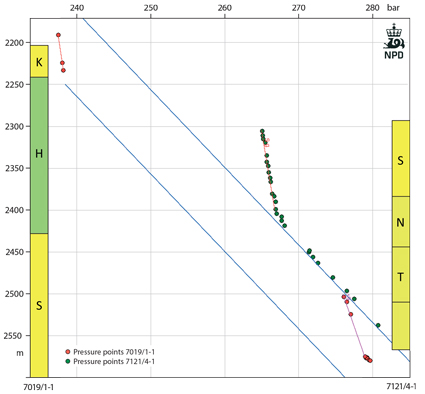Seal capacity
7019/1-1 discovery
The 7019/1-1 well was drilled by ENI in 2000 on a rotated, down-faulted block facing the Harstad Basin. The well encountered gas in two reservoir horizons, the Middle Jurassic Stø Formation and the Lower Cretaceous Knurr Formation. It was reported that the Jurassic Stø Formation contained at least 50% CO2. The gas would not ignite during a short test. The CO2 content in the Lower Cretaceous is less, roughly 15%. The permeability was low in the Stø Formation due to diagenesis and stylolitization at that depth, while some of the sandstone layers in the Lower Cretaceous 300 m shallower had good permeability and porosity.
A test was performed in the interval 2526 to 2563 m in the Stø Formation. The well flowed 606,000 m3 gas per day (no liquid) from a 40/64 choke. Gas gravity was 1,133 (air = 1), CO2 content 60 - 70%, and H2S content 6 - 13 PPM. The test was stopped during the clean-up phase due to the high CO2 content.
A plot of the pore pressures shows that the difference in pressure between the Cretaceous and Jurassic gas gradients is almost 3 MPa (30 bar). There are no pressure data from the water zone in the Knurr Formation. Assuming a contact of 2250 m based on the log data, the pressure difference between the water zones is 0.5 MPa (5 bar). The Cretaceous gas gradient from the pressure plot is similar or slightly lower than the gas gradient in the Snøhvit field (0.018 bar/m), while the Jurassic gradient indicates a considerably heavier gas (more than 0.03 bar/m). These gradients seem to be consistent with a high CO2 content in the Jurassic reservoir reported from the well test, while the proportion of CO2 in the Cretaceous reservoir is interpreted to be similar to the Snøhvit area.
The pressure data show that the Upper Jurassic shale between the two reservoirs has good sealing properties. A large difference in CO2 concentration between the two reservoirs implies that the Upper Jurassic seal is capable of containing CO2 for a long period (geological time scale). The sealing capacity of the Upper Jurassic cap rock in the Barents Sea has been debated, because many wells in areas with net uplift show evidence that methane gas has leaked from the reservoirs. The amount of erosion of the overburden in the typical Hammerfest Basin wells is estimated to be less than in 7019/1-1. Consequently, other factors than net uplift are also considered important for the evaluation of seal capacity.
The pressure plot also shows that the pore pressure in the water zone is lower in 7019/1-1 than in the Snøhvit area. Similarly, slightly lowered water pressures are observed in block 7120/12. One possible explanation for this is that the salinity of the aquifer brine is lower in these areas.

Fig-6-065

Gammalog Density - neutron log
Fig-6-066
